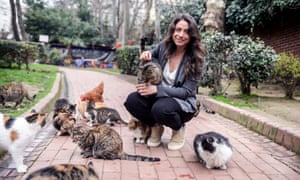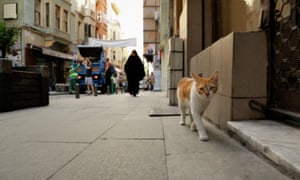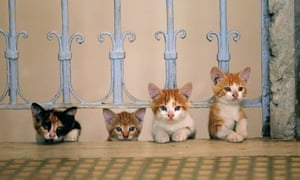‘I made a love letter to the city and the cats’
Street cats have roamed Istanbul for centuries. As a film starring some of them opens, director Ceyda Torun explains why the likes of ‘Psycho’ and ‘Hustler’ are so at home there
Kathryn Bromwich
Sunday 18 June 2017 07.30 BST
F
ilm-maker Ceyda Torun grew up in Istanbul until the age of 11 and is now based in Los Angeles. Her feature-length documentary debut Kedi (Turkish for “cat”) is about seven of the street cats that roam Istanbul. They are cared for collectively by the community in exchange for mouse catching, affection and “good energy”. Each cat has a distinct personality: Sari, “the Hustler”, is a tabby who inventively seeks out food for her kittens; Psikopat, “the Psycho”, is a fierce black and white cat with a strong sense of territory; Gamsiz, “the Player”, is a resourceful short-haired who has charmed the neighbourhood baker with his moxie.
A surprise box-office hit (the film has made more than $2.7m in the US), Kedi has a 97% rating on Rotten Tomatoes and was described by IndieWire as “the Citizen Kane of cat documentaries”.
What did growing up with street cats add to your childhood?
I was a happy-to-be-alone kind of child and the cats were companions in the heavily imaginary little world I would create in our back yard. I learned a lot from them, about my own strength, my own physical capabilities. One cat came into my life when I was seven; she stayed on and kept giving birth to kittens and I took care of them. She’d walk on the top of a wall and I’d walk behind her and I’d do all these things I may not have had the courage to do without her. I also learned about companionship and setting boundaries – cats definitely set boundaries for you.
How did you decide to make a film about Istanbul’s cats?
I’ve been working in narrative films for the past 15 and 20 years and had no intention of making a documentary. But a few years ago, my cinematographer and producing partner Charlie [Wuppermann] and I decided this was a good excuse to spend a few months in Istanbul, where my entire family is. We know that people are fascinated by the cats in Istanbul – whenever non-Turkish friends come to visit they comment on the uniqueness of the situation.
With help from local film-makers we found cats in hammams, museums, mosques… We had about 35 cat stories and in the end filmed 19 of them, because of course cats don’t always show up where they’re supposed to. And I had a very clear rule: if we approached the cat and she didn’t want to be filmed, we left; if she stuck around that meant she was giving us permission to shoot.
Why are there so many street cats in the city?
There are a few reasons. There’s the historical factors – that cats have been in this geography for so long. We interviewed a veterinary zoologist who showed us a cat skeleton that had been found while building the new tunnel under the Bosphorus. It was from 3,500 years ago and had a break in the thigh bone that could only have healed like that if a human had wrapped its leg. So his theory was that this relationship – tending to cats and cats helping us fend off mice – goes back to at least then.
Then there’s the Islamic element: cats are highly revered in Islam and there are multiple references to the prophet Muhammad having a cat. Often, people use that to justify taking care of them. There are people who don’t like cats and are bothered by others taking care of them, but [their frustration] is more a reflection of the city’s overcrowding, I think – the population has gone from 4 million in my childhood to close to 20 million now.
What do the cats mean to the people of Istanbul?
There’s nobody here that doesn’t have a memory of cats: no grandmother, no generation has been here without cats, so they’re ingrained in our collective memory. People tend to be in awe of the freedom cats have, their ability to go in and out of almost anywhere. They show up in political situations, universities; they go in and out of places that are forbidden or dangerous for humans. And cats provide this wonderful opportunity for people in Istanbul to pick a moment to be affectionate with a being that doesn’t judge them, that doesn’t have complicated human relationship issues. We have a lot of “cat daddies”.
How are street cats different from house cats?
I’ve always thought house cats were a bit more snobby with strangers, because they have dedicated humans at home. Street cats approach you in the same way a house cat would approach his owner: you might be sitting at a park bench in Istanbul and a cat will maybe come and snuggle with you a little bit. But some cats are outgoing, some are shy: they are individual in that sense.
You’ve never “owned” a cat – would you like to in the future?
I would love to be surrounded by as many cats and animals as I could be, but I first have to create that environment for myself. So I’m trying to think of it in an opposite order: how can I fit my life to nature a little bit better, so that maybe I could have a community cat with a bunch of neighbours? It’s a tough one, because I can never recreate that original experience I had with cats as a child. But I’m trying.
How did you find the people you interviewed?
By walking the streets and asking people absurd questions about cats. We would see somebody interacting with a cat and talk to them about it. We saw a sign on a wall that said “Do not take these water cups, they’re for the cats and dogs” and assumed they must have been written by some old lady. But a burly, working-class guy, who was unloading these barrels of chains for a boat, came up and said: “I wrote this.”
We tried to find places that could bring unique situations, like the guy who has four cats in his boat who go fishing with him. That’s how cats must have travelled the world with us, but to see visual evidence of it was really fascinating. We also had conversations with writers, poets, artists, philosophers, scientists and archaeologists, who are quoted in the film too.
Given the recent unrest in Turkey, how are people in the city feeling?
People are depressed and anxious here, as I think they are in the rest of the world. They are trying to be resilient about events, but it is really tough; there’s a sort of cloud hanging over everything. All these things were happening in distant ways while we were filming during the summer of 2014. Charlie and I discussed it daily, how we could defend to ourselves making a film about cats, as opposed to about Syrian refugees in Istanbul or political upheavals in the country. These are very important topics that must be explored, but at the same time they require a perspective that we weren’t able to provide.
What I knew I could make was a love letter to the city and the cats. I could immortalise the beauty of the city – that’s my form of resistance. It’s been screening in the US and people are saying: “Wow, I didn’t know Muslims were like this.” And people are responding positively to it in Istanbul as well, to be reminded of the things that are beautiful.
Was it also an attempt to show a different side to the city?
There are very few documentaries about Istanbul that are truly authentic to people who are from there – they are almost always done from the perspective of foreigners. I have this situation of having been away from the city, but completely in touch with it. I come back frequently enough that I see the changes clearly, but then I’m far enough away that beautiful things are still nostalgic and fresh. I really wanted to show the world that Istanbul isn’t like what we see in news headlines, or a Bond movie or through a tour guide. Capturing the real city was very important to me.
How has the city changed in recent years?
Since we made the film, the tramline has been paved over, buildings have changed. A whole bunch of things have happened [politically], which is another reason I’m so grateful I made this when I did – I really wouldn’t be able to do it right now. I probably wouldn’t get permission to film anything.
Are you still in touch with any of the people you spoke to?
Yes, I’m in Istanbul now and came to visit a lot of them. A few cats haven’t survived in the last years, of course, while a few are resilient and may never die – Psikopat is one of those. Gamsiz is well; even though the baker has moved out of town, the cat is still there.
Since there’s so much bad news in the world, was the film a deliberate decision to look for something positive?
Absolutely. I think there needs to be an equal amount of effort to create emphasis on the good as well as the negative. We could be skewing our perspective of life – it’s really not all horrifying.
We are carrying the entire weight of the world on our shoulders and it’s a really heavy burden to bear. We’re often dealing with the ongoing struggle of people who live thousands of kilometres away from us, where we have absolutely no power to do anything about it. So I wanted to counteract that and I wanted to immortalise certain things that are good, as an act of my own kind of protest. Say 30 years from now, if you see this film, I want the positivity and the warmth of it to resonate in our memory. Because that’s what it’s there for, right?
• Ahead of its nationwide cinema release on 30 June, director Ceyda Torun will take Kedi on a UK tour, starting with a screening and Q&A on 26 June at BFI Southbank, London SE1. Tickets and further information are available at kedifilm.co.uk






No comments:
Post a Comment